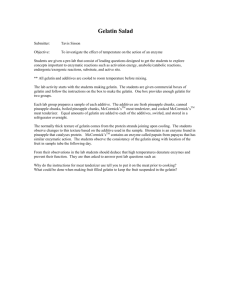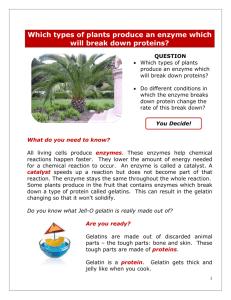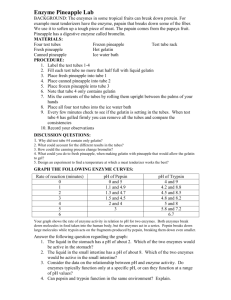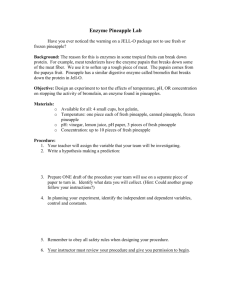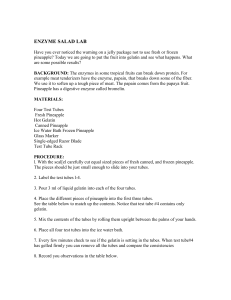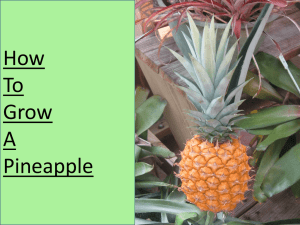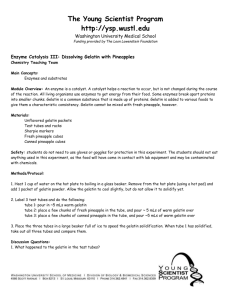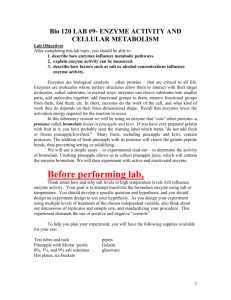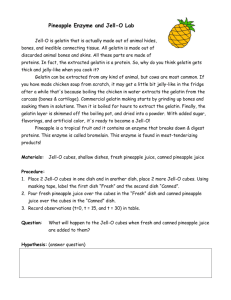Cellular Respiration Lab - ahs
advertisement
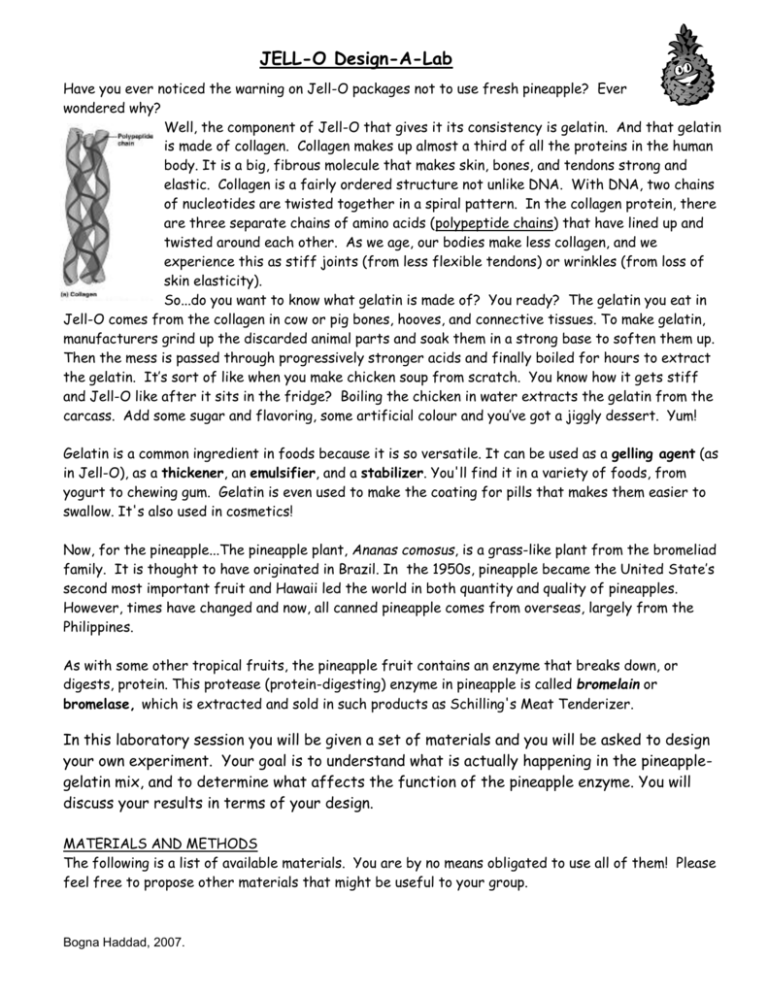
JELL-O Design-A-Lab Have you ever noticed the warning on Jell-O packages not to use fresh pineapple? Ever wondered why? Well, the component of Jell-O that gives it its consistency is gelatin. And that gelatin is made of collagen. Collagen makes up almost a third of all the proteins in the human body. It is a big, fibrous molecule that makes skin, bones, and tendons strong and elastic. Collagen is a fairly ordered structure not unlike DNA. With DNA, two chains of nucleotides are twisted together in a spiral pattern. In the collagen protein, there are three separate chains of amino acids (polypeptide chains) that have lined up and twisted around each other. As we age, our bodies make less collagen, and we experience this as stiff joints (from less flexible tendons) or wrinkles (from loss of skin elasticity). So...do you want to know what gelatin is made of? You ready? The gelatin you eat in Jell-O comes from the collagen in cow or pig bones, hooves, and connective tissues. To make gelatin, manufacturers grind up the discarded animal parts and soak them in a strong base to soften them up. Then the mess is passed through progressively stronger acids and finally boiled for hours to extract the gelatin. It’s sort of like when you make chicken soup from scratch. You know how it gets stiff and Jell-O like after it sits in the fridge? Boiling the chicken in water extracts the gelatin from the carcass. Add some sugar and flavoring, some artificial colour and you’ve got a jiggly dessert. Yum! Gelatin is a common ingredient in foods because it is so versatile. It can be used as a gelling agent (as in Jell-O), as a thickener, an emulsifier, and a stabilizer. You'll find it in a variety of foods, from yogurt to chewing gum. Gelatin is even used to make the coating for pills that makes them easier to swallow. It's also used in cosmetics! Now, for the pineapple...The pineapple plant, Ananas comosus, is a grass-like plant from the bromeliad family. It is thought to have originated in Brazil. In the 1950s, pineapple became the United State’s second most important fruit and Hawaii led the world in both quantity and quality of pineapples. However, times have changed and now, all canned pineapple comes from overseas, largely from the Philippines. As with some other tropical fruits, the pineapple fruit contains an enzyme that breaks down, or digests, protein. This protease (protein-digesting) enzyme in pineapple is called bromelain or bromelase, which is extracted and sold in such products as Schilling's Meat Tenderizer. In this laboratory session you will be given a set of materials and you will be asked to design your own experiment. Your goal is to understand what is actually happening in the pineapplegelatin mix, and to determine what affects the function of the pineapple enzyme. You will discuss your results in terms of your design. MATERIALS AND METHODS The following is a list of available materials. You are by no means obligated to use all of them! Please feel free to propose other materials that might be useful to your group. Bogna Haddad, 2007. -test tubes & test tube rack -cooked pineapple -glass marker - stirring rods - a “daily special” assortment of other fruit to test -gelatin -canned pineapple -fresh pineapple -frozen pineapple -ice -pipettes - knife for cutting pineapple STEPS TO COMPLETE (during this period) 1. Use the attached sheet to design a controlled experiment that shows the effect of pineapple and at least two other fruits on gelatin. Make sure your experiment description includes the following: a. A testable hypothesis. Remember hypotheses are written as “If…then” statements. b. A detailed experimental design which will include: 1. The effect of fresh pineapple on gelatin. 2. The effect of frozen pineapple on gelatin. 3. The effect of canned pineapple on gelatin. 4. The effect of freshly cooked pineapple on gelatin. 5. The effect of two other fruits on gelatin. 6. A test to determine how gelatin behaves without any additives. c. A data table for recording information 3. Write up a detailed experimental plan on the accompanying sheet of paper. 4. You will be able to perform your experiment once you receive approval of your experimental design from your teacher. Bogna Haddad, 2009. Name __________________________ EXPERIMENTAL DESIGN GUIDE Teacher Approval_________ TITLE HYPOTHESIS (If...then) INDEPENDENT VARIABLE MEASUREMENT OF INDEPENDENT VARIABLE NUMBER OF TRIALS DEPENDENT VARIABLE MEASUREMENT OF DEPENDENT VARIABLE CONTROL OTHER CONTROLLED FACTORS (AT LEAST 5) Bogna Haddad, 2009. LAB WRITE UP QUESTIONS 1. Clearly describe the results of your experiment. In which test tubes did the gelatin solidify? Which did not? 2. Clearly explain the results of your experiment. Why did some test tubes of gelatin solidify and other not? Be specific! 3. What is the enzyme in your experiment? 4. What is the substrate in your experiment? 5. What is (are) the product(s) in your experiment? 6. What type of organic molecule is gelatin? 7. What type of organic molecule is bromelain? 8. Write a “word equation” to describe the chemical reaction that occurs when pineapple is mixed with the gelatin. 9. Is the reaction of bromelain and gelatin a dehydration synthesis or a hydrolysis? Explain. 10. Why were the results of the freshly cooked pineapple different than the results of the fresh, raw pineapple? Be specific! 11. What is meat tenderizer and what does it do? 12. On the accompanying sheet of paper, design an experiment to test at what specific temperature the pineapple enzyme denatures. Bogna Haddad, 2009. Name __________________________ EXPERIMENTAL DESIGN GUIDE TITLE HYPOTHESIS (If...then) INDEPENDENT VARIABLE MEASUREMENT OF INDEPENDENT VARIABLE NUMBER OF TRIALS DEPENDENT VARIABLE MEASUREMENT OF DEPENDENT VARIABLE CONTROL OTHER CONTROLLED FACTORS (AT LEAST 5) Bogna Haddad, 2009. Notes to teacher: -to prepare the gelatin: stir two envelopes of KNOX unflavoured gelatin into 800 mL of hot water (be sure that it's not boiling when pipetted or you will denature all of your bromelase), store in a warm water bath when the students are using it to ensure that it pours easily - ensure that the students are not mixing up the scalpels when cutting the different types of pineapple (set up pineapple cutting stations that are physically removed from each other) per station - test tube rack - 5 test tubes - wax pencil - pipette - wooden flint/glass rod (to scrape out gelatin) every bench - ice bucket shared - pineapple: cooked/fresh/canned/frozen on four labeled trays, two samples of each - other fruit with gelatin degrading properties: kiwi, papaya, ginger - other fruit with not-gelatin degrading properties: anything else - four labeled trays - dishes for pineapple (8) - scalpels and tweezers (8, 2 per tray) - KNOX 1 package (makes 400 mL) per class (need 225 mL per 15 groups) - 2 x gelatin beakers - 1 hot plate with hot water for rinsing pipettes - 2 hot plates with hot water baths for gelatin - ice - detergent - test tube brushes Bogna Haddad, 2009.
